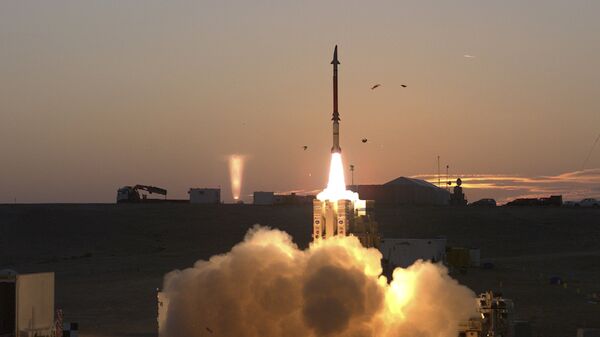Under the treaty, negotiated as part of the Strategic Arms Limitation Talks that established limits for strategic offensive weapons, the United States and the Soviet Union could establish but two anti-ballistic misisle sites. One would protect their national capital, one would protect an intercontinental ballistic missile launch site — the sites, each of which could have a maximum of 100 interceptors and 100 launchers, were required to be at least 1,300 kilometers apart to prevent the creation of a regional defense zone.
On May 26, 1972, Richard Nixon and Leonid Brezhnev sign the SALT I treaty in Moscow, as well as the Anti-Ballistic Missile Treaty. pic.twitter.com/wsWr1oWEv2
— History (@HistoryTime_) May 26, 2017
The treaty did not limit the number of early warning radars each country could deploy, but stipulated future radars must be sited on the countries' borders facing outwards. Both parties also agreed not to develop sea-based, air-based, or space-based ABM systems. In 1974, the treaty was updated, limiting each side to only one ABM site.
Anti-ballistic Missile Treaty signed May 26, 1972 allowing two sites with 100 missiles and launchers #TBT pic.twitter.com/Aq1Fc8ju6P
— USASMDC/ARSTRAT (@ArmySMDC) May 26, 2016
Each member could verify the other party's compliance using technical verification, such as satellite reconnaissance and the like. A Standing Consultative Commission was also created, where each country was represented by a Commissioner, Executive Officer and delegation. While the body could not impose sanctions on signatories for violating the treaty, it did allow parties to raise compliance concerns. It went on to serve as a vital body through which the US and Soviet Union remained in communication, even when tensions rose again under Ronald Reagan's Presidency, and other diplomatic initiatives failed.
Moreover, Dave Webb, Chair of the Campaign for Nuclear Disarmament, says the treaty was effective in stopping the implementation of missile defense systems.
"It maintained balance between the US and Soviet Union — it was understood if one side rolled out such a system, they would be at a strong advantage, able to strike first and mop up any retaliation. It was also understood doing so could create an arms race between the two sides," Mr. Webb told Sputnik.
In essence, the treaty recognized offensive weapons and defensive systems are linked — and created strategic stability between the two adversaries, allowing both to reduce their nuclear arsenals for the first time. While the Soviet Union ceased to exist December 25 1991, the US continued to view the treaty as valid, and in 1997 it was expanded to include the Soviet Union's successor states of Belarus, Kazakhstan, Russia and Ukraine.
OTD 2001 Geo. W Bush announces US withdrawal from 1972 ABM Anti-Ballistic Missile Treaty w/ Russia. pic.twitter.com/dLrZxR1ua7
— (((Hawkeye))) (@inhuggermugger) December 14, 2016
However, in December 2001, then-President George W. Bush announced the US planned to withdraw from the ABM Treaty. Six months later, almost exactly 30 years after its signing, the US did just that, to date the first and only time a major power has backed away from an arms treaty in history.
At the time, Russian leaders were not threatened by the withdrawal, but President Vladimir Putin nonetheless called the move "a mistake."
Mr. Webb notes the day after the treaty's notice period ended, the US started building anti-ballistic missile sites in Alaska and California — while the treaty stopped the implementation of these systems, research and development didn't halt, and the US had created a system [Ground-Based Midcourse Defense] they thought they could put in to operation. It was claimed by US leaders the withdrawal was necessary to guard against the threat of North Korea and Iran acquiring long-range nuclear weapons and/or missile capabilities — but as of 2017, neither country has fielded such a weapon.
"Under the Obama administration, a sea-based system was developed — Aegis warships are currently hosted by Spain, in the Mediterranean Sea. Controlled from the Rammstein airforce base in Germany, they patrol Europe and the Baltic states. There are also anti-ballistic missiles positioned in Romania, and plans to put more in Poland in future. There are radar sites across the word, including in Britain and Turkey. This is a vast international system," he added.
@We3forDemocracy It is of note that under Bush, the US withdrew from the 1972 Anti-Ballistic Missile Treaty. pic.twitter.com/GkHnwDShKp
— ThreeMonkeys AndMe (@We3forDemocracy) December 30, 2015
Given the non-existence then and now of a long-range threat from Iran and North Korea, the obvious question is who or what the system is aimed at. For Mr. Webb, the answer is simple — it is "very obviously" aimed at Russia.
Putin: US unilateral withdrawal from the Anti-Ballistic Missile Treaty leads to a Cold War pic.twitter.com/UpR6NMfwJw
— Poyta Galvin (@PoytaGalvin) June 19, 2015
The impact of the US reneging on the treaty is seismic. For one, it has compelled Russia to maintain the size of its nuclear arsenal, in order to counter the system should the need arise — and Mr. Webb suspects it has encouraged North Korea's nuclear program, a source of worry for governments and populations the world over.
"US withdrawal has not done any good for peaceful cooperation between countries. It has made things a lot worse, killing further talks on nuclear disarmament, and increasing tensions between nuclear states. South Korea has now implemented an aerial defense system, which has made China and Russia alike feel angry and intimidated. With disarmament off the table, all nuclear countries have spent trillions combined on updating their systems. What's more, it's unclear how accurate these anti-ballistic missiles are — they continually fail tests, so it's not clear the billions spent on their development hasn't been a complete waste," Mr. Webb added.
.@UN Tim Wright on the first draft of the world's first nuclear weapons ban https://t.co/zzYYmP37EB #nuclearban pic.twitter.com/ffOniNkU3v
— BulletinOfTheAtomic (@BulletinAtomic) May 26, 2017
From June 15 to July 7, at the United Nations offices in New York, a negotiating conference will be held on the future of nuclear weapons — and there will be a subsequent vote on banning nuclear weapons. If successful, the motion will end the days of nuclear weapons being the only weapons of mass destruction not prohibited under international law in a comprehensive and universal manner. If successful, Mr. Webb believes there will be quite some pressure on states presenting themselves as humanitarian and law-abiding to do something about their nuclear systems.
"I expect most countries will vote in favor. The time has come to abandon these systems, and for the nuclear race to end. Instead of developing nuclear weapons, countries should work cooperatively against the dangers facing the world, like climate change," he concluded.



